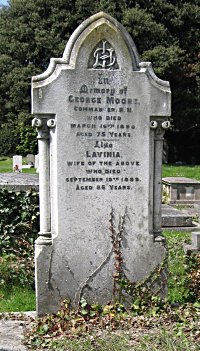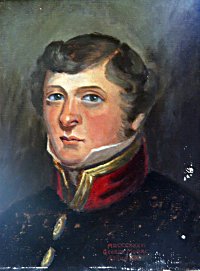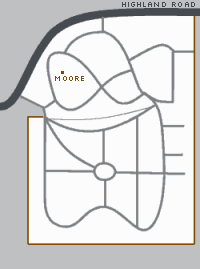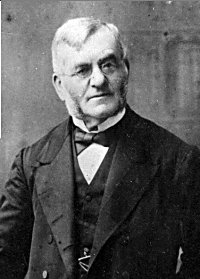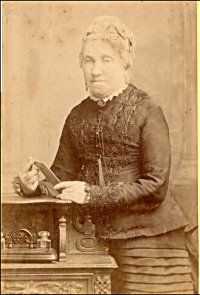 |
 |
|
|
ARMY AND NAVY
George Moore, Commander RN
Gravestone Inscription
memory of
George Moore
Commander RN
who died
March 16th 1890
aged 75 years
Also
Lavinia
wife of the above
who died
September 19th 1899
aged 86 years.
Biographical Notes by David Moore (1917-2001)
My great-grandfather George Moore was born in 1815. His father William had married a lady whose surname was Kains, and they had a number of children. All that is known of George's brothers (or sisters) is that three of his brothers were called Charles, Joseph and Edwin - nothing more is known of these siblings, or of their descendants if any. It is believed that the family lived in
Rochester, Kent, and that William Moore died there in 1873. George was educated at the Royal Naval School at Greenwich. This is evidence that his father had served in the navy, because places at the school were reserved for children of naval ratings, and possibly, at that time, of subordinate officers such as Midshipmen. George entered the Royal Navy in about 1830, the exact year being unknown.
It is fairly certain that he entered as a Second Class Volunteer, because he subsequently became a Master. At any rate George must have obtained an appointment to a ship as an officer under training for master, and this argues strongly that his father William had been in the Navy, and probably as a Midshipman.
I do not know precisely how George Moore was trained, but he probably progressed from Second Class Volunteer to Master's Assistant and thence to Second Master. According to the Navy List of 1843, however, he had reached the rank of Second Master and was serving in HMS URGENT, a steam vessel having two guns, at Liverpool. Her Captain, who held the rank of Master-Commander, was John Emerson. George had joined the ship on 15 November 1842. At this time the monthly pay of a Second Master ranged from £5 9s 4d when serving in a First Rate to £4 14s in a Sixth Rate. The URGENT was probably classed as the latter. In fact it may be that George had entered the Navy directly as a Master's Mate (or Assistant) under the patronage of the Master Commander of a small ship.
It was probably some time between 1840 and 1842 that George married Lavinia Bowden, who was a year or so older than him. My father believed that he was then serving, probably as a Master's Assistant, in one of the Falmouth 'Packets', which were small ships used to take Her Majesty's mails to Ireland. Lavinia came from a Falmouth family, her father being William Bowden, a Master Commander. George had previously been engaged to Lavinia's sister, 'sweet' Nellie, but she had died.
In 1843 three events of importance to our story occurred. First, the Admiralty elevated the position of Master from warrant to commissioned rank - Masters were now entitled to use the Wardroom Mess in a ship instead of the Warrant Officers' Mess. Secondly, George Moore was promoted to the rank of Master with seniority of 2 September 1843. Thirdly, George and Lavinia's eldest son George Kains Moore was born on 11 October 1843. One imagines that there were some celebrations in the Moore family in the autumn of that year.
On 20 December 1844 George joined HMS DARING, a brig of 12 guns, as Master, under Commander William Peel as Captain. The ship was destined for the North America and West Indies station. In addition to Cdr. Peel and George there were six other officers on board DARING. It is believed that it was about this time that George's portrait (above) showing him in full dress, with red facings, was painted in oils by a shipmate.
George and Lavinia's second son Richard Edwin was born on 12 October 1845, presumably while George was still abroad in DARING. We can assume that he returned home towards the end of 1848, because their third son William John (my grandfather) was born on 14 August 1849. William was followed by their last child Thomas some time in 1851. All four sons were destined for naval service as officers. Their parents' home was in Falmouth when they were small.
On 8 July 1849 George joined HMS THETIS, a ship of 8 guns, as Master, for the Pacific Station. He was sixth in command out of 16 officers, under Captain Augustus Leopold Kuper. My father knew that at some stage George had been Master Attendant, ie the officer in charge of berthing ships, in the RN Dockyard at Esquimalt, on Vancouver Island, off the west coast of Canada. It being the custom always to appoint officers to ships, rather than to shore establishments, it may well be that THETIS was the base ship to which RN officers serving in the Dockyard were appointed: or possibly George was temporarily appointed as Master Attendant there during a prolonged visit by THETIS. He remained in THETIS for at least three years, returning home in time to be appointed as Master of the battleship HANNIBAL on 20 March 1854. This heralded the most important period of his naval career, because HANNIBAL took part in the Crimean War. In appearance the HANNIBAL was very similar to the ships-of-the-line of Nelson's era, but she did have steam engines of 450 hp working a screw-propeller, in addition to a complete set of masts and sails. George was seventh in the chain of command under Captain the Hon. Fred W. Grey.
Admiral Sir Charles Napier sailed for the Baltic on 11 March 1854 with the first part of the Baltic fleet; he had no local pilots with him, so a difficult task lay ahead for the Masters. A combined British and French fleet had already entered the Black Sea, and Napier was later joined by some French warships. War was declared a week after George joined the HANNIBAL, which it can be assumed proceeded to the Baltic as soon as she was ready.
The Russian Baltic fleet had decided to shelter behind the massive fortress of Kronstadt which protected the approach to the Russian capital of St Petersburg. In August with the aid of his marines and French troops, Napier attacked an outlying fortress at Bomarsund in the Aland Islands at the entrance to the Gulf of Bothnia, between Finland and Sweden, but then belonging to Russia.
This attack was successful and the fortress was destroyed. HANNIBAL, it is believed, was involved in this operation. In the 1855 Navy List HANNIBAL is shown as being in the Mediterranean Command wearing the flag of Rear-Admiral Houston Stewart, commanded by Captain John Hay, and with Commander Oliver Jones as executive officer. George was now Master of a flagship.
The war was not yet over, and HANNIBAL was one of six ships of the line that successfully attacked the forts at Kinburn, protecting the entrance to the Dnieper river, on 17 October 1855. The battleships were supported not only by gunboats and mortar-vessels which could get close inshore, but by 4000 troops who were landed near the forts. This action was the first in which ironclad warships were used, some of the French ships being protected by iron armour plates. Before the attack, a careful survey and sounding of the dangerous shoals and unknown channels surrounding the forts had been carried out. George may have been involved in these preparations. My great-grandfather must have left HANNIBAL in the spring of 1856, at about the time that the war came to an end. As a result of his service in the Crimean war he received three medals:
(1) Crimea Medal dated 1854, with oak leaf 'Sevastopol', and a blue ribbon edged yellow.
(2) 'La Crimea' Medal dated 1855, with pink ribbon edged green.
(3) Baltic Medal 1854-55, with yellow ribbon edged blue.
The next mention of George is as Master Commander of the screw-steam tank-vessel WYE, which he joined in the Mediterranean on 12 June 1856. So now he was captain of his own ship, and had as his assistant Second Master Joseph Blackwood. He remained with this command until December 1857 when he took command of a store vessel at Woolwich for two months. From there he was appointed on 1 February 1858 to the coastguard service at Milford Haven, where it is known that he held the position of Master Attendant at Pembroke Dock. He had been away for four years and his sons, aged 14, 12, 8 and 7 years, hardly knew him on his return from the Mediterranean. It is believed that the family had moved from Falmouth to New Cross (SE London), where the boys began attending the Royal Naval School there, a private one. From 1858 onwards George had a series of six ship appointments all connected with the Coastguard Service, Liverpool or Pembroke Dock, until his retirement in April 1870 at the age of 55. What part of this period of 12 years was spent at Milford Haven and what part, if any, elsewhere is a matter for conjecture. We know from a letter that George's address in September 1863, was Stanley Terrace, Holyhead.
George was promoted to Staff Commander in June 1863. The pay of a Staff Cdr., being qualified for Line-of-Battle Ships, and having completed 20 years' service on full pay, was £328.10s per year
When George retired in 1870, all four of his sons had entered the naval service as officers. A distinct Retired List of officers (as opposed to the Active List) had been introduced as recently as 1864, and on retirement he was entitled to the rank of Commander. He and Lavinia moved to Southsea, where they lived in a house called Penrhos in Victoria Road North (since demolished and replaced by flats). In those days this area was in the midst of orchards and fields. George and Lavinia lived there in some comfort with two maids, Kate and Susan, and a parrot Jo. The last named eventually laid an egg and was re-christened Josephine. It is handed down that George would walk across the fields to Commercial Road, Portsmouth, where he bought medicines more cheaply at a little chemist's shop kept by a man called Timothy White. George died at the age of 75 on 16 March 1890, and Lavinia on 19 September 1899 aged 86.
